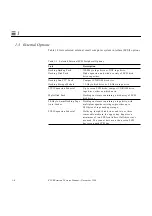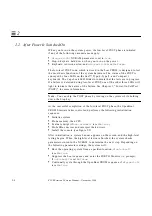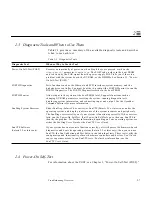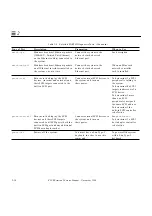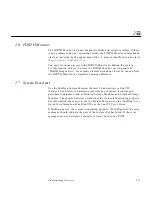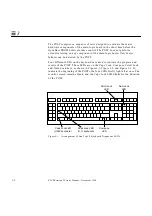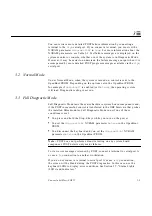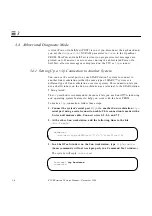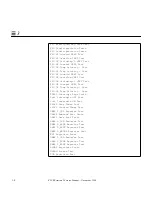
Troubleshooting Overview
2-7
2
2.3 Diagnostic Tools and When to Use Them
Table 2-3 provides a summary of the available diagnostic tools and describes
when to use each tool.
2.4 Power-On Self-Test
For information about the POST, see Chapter 3, “Power-On Self-Test (POST).”
Table 2-3
Diagnostic Tools
Diagnostic Tool
Wh
e
n or Why to Use the Tool
Power-On Self-Test (POST)
Executes automatically at power-on when Stop-d keys are pressed or when the
diag-switch?
parameter is set to
true
. The POST code resides in the boot PROM
and is driven by the POK signal from the power supply. POST tells you if there is a
problem with the system board, the NVRAM, or the DSIMMs. See Section 3.1, “Power-
On Self-Test (POST).”
FORTH Diagnostics
Tests functions such as the Ethernet and SCSI interfaces, system memory, and the
diskette drive controller. You must be at the
ok
prompt (the FORTH Monitor) to run the
FORTH Diagnostics. The FORTH Diagnostics reside in the boot PROM.
FORTH Monitor
Allows input to the system at the boot PROM level. Supports functions such as
changing NVRAM parameters, resetting the system, running diagnostic tests,
displaying system information, and redirecting input and output. See the OpenBoot
Command Reference for more information.
SunDiag System Exerciser
Either SunDiag (Solaris 2.4 or earlier) or SunVTS (Solaris 2.5 or later) runs under the
operating system, and display real-time use of the system resources and peripherals.
The SunDiag exerciser tells you if your system is functioning correctly. If the exerciser
fails, run the Power-On Self-Test. If all Power-On Self-Tests pass, then run SunVTS to
identify the problem. For further information, depending on your operating system, see
either the SunDiag User’s Guide or the SunVTS User’s Guide.
SunVTS Software
(Solaris 2.5 or later only)
If your system does not seem to function correctly, yet it still passes the firmware-based
diagnostics and boots its operating system (Solaris 2.5 or later only), then you can use
SunVTS, the Sun Validation and Test Suite, to run individual tests. These tests verify the
configuration and functionality of most hardware controllers and devices. You’ll need
root or superuser access to run SunVTS tests. For further information, see the
SunVTS User’s Guide.
Summary of Contents for SPARCstation 5
Page 12: ...x SPARCstation 5 Service Manual November 1996...
Page 22: ...xx SPARCstation 5 Service Manual November 1996...
Page 23: ...Part 1 SystemInformation Chapter 1 Product Description...
Page 24: ......
Page 32: ......
Page 44: ...2 12 SPARCstation 5 Service Manual November 1996 2...
Page 64: ...4 10 SPARCstation 5 Service Manual November 1996 4...
Page 65: ...Part 3 PreparingforService Chapter 5 Safety and Tools Requirements Chapter 6 Power On and Off...
Page 66: ......
Page 72: ...5 6 SPARCstation 5 Service Manual November 1996 5...
Page 78: ......
Page 130: ...9 32 SPARCstation 5 Service Manual November 1996 9...
Page 132: ......
Page 136: ...10 4 SPARCstation 5 Service Manual November 1996 10...
Page 162: ...11 26 SPARCstation 5 Service Manual November 1996 11...
Page 163: ...Part 6 IllustratedPartsBreakdown Chapter 12 Illustrated Parts Breakdown...
Page 164: ......
Page 172: ......
Page 176: ...A 4 SPARCstation 5 Service Manual November 1996 A...
Page 198: ...D 10 SPARCstation 5 Service Manual November 1996 D...
Page 208: ...SPARCstation 5 Service Manual November 1996...
Page 210: ......






